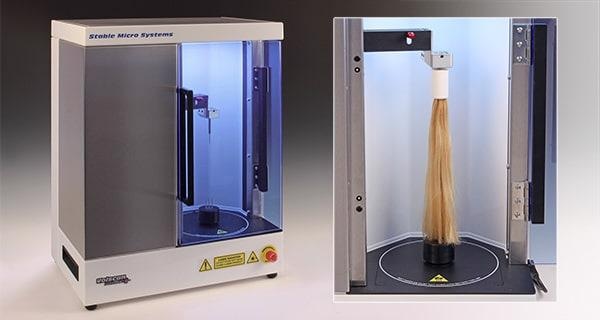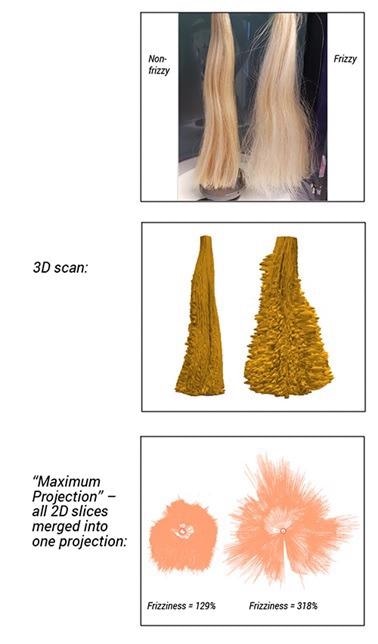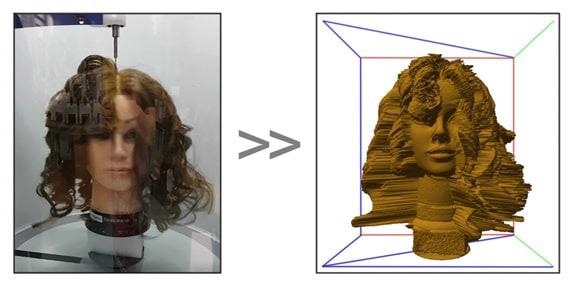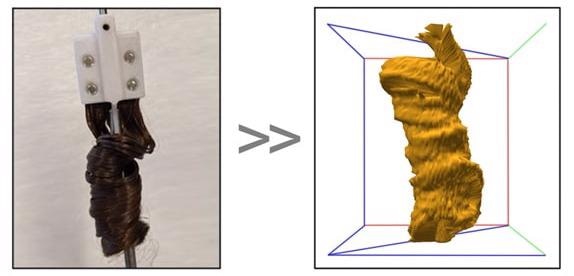During marketing and promotional activities, hair products are frequently described as offering good ‘body’ to the hair while taming frizz and flyaways. The efficiency of these products must be verified scientifically, however.
High body can be loosely defined as thick, bouncy hair with high volume and a good amount of movement as the head is turned. This may also be characterized as hair with a good amount of elevation from the scalp in both the lateral and vertical directions.
Conducting a hair body measurement using the Volscan Profiler involves dynamic testing and sample movement in combination with laser measurement. This instrument also offers a diverse array of digital dimensional measurements with fast analysis times.

Image Credit: Stable Micro Systems Ltd
The Volscan Profiler is a powerful, laser-based benchtop instrument employed in the measurement of volume and dimensional profiles of hair tresses and mannequin heads.
These measurements allow the instrument to provide a quantitative evaluation of hair volume, frizziness and curl retention essential in product development and performance evaluation.

Volscan Profiler with hair tress sample. Image Credit: Stable Micro Systems Ltd
How a Volscan Profiler Measures Hair Tress Volume
During a typical measurement, a hair tress will be centrally supported between the instrument arm and instrument base, allowing it to hang freely.
The Volscan Profiler is able to rotate the sample at a specified rate throughout the scanning process, thus causing the tress to splay. While this rotation is occurring, a vertically moving laser is used to map the contours of the splayed hair tress.
A range of calculations is performed on the resulting 3D scan, revealing measurements of volume and frizziness and enabling an assessment of the impact of tress preparation or any added treatments.

Comparison of two tress samples; 3D scans of tresses; maximum projection scans. Image Credit: Stable Micro Systems Ltd
Calculations Used for the Determination of Hair Properties
The most important considerations when scanning a hair tress sample are related to the way in which the sample’s bulk spreads out as it is rotated.
The most commonly used of these parameters is the volume of the hair sample because this can facilitate a rapid estimation of hair body.
Another potential calculation is the surface area of the scan. This value will be larger for hair that has more body and movement because it is primarily associated with the spreading out of hair.
Maximum projection is an area calculation that evaluates the splayed hair tress as it is turning. This calculation represents the body of the hair and evaluates the hair tress as if it were viewed directly from below. Hair that has spread out more while turning will have greater body, and this will cover a larger projected area.
The largest radius of the maximum projection signifies the furthest flung hair, providing an assessment of the absolute maximum movement of the hair from its most central point.
Frizziness can be calculated by utilizing the jaggedness of the maximum projection outline of a 2D scan, then comparing this with a mathematically smoothed outline. When working with this calculation, the frizzier the hair is, the more jagged the outline will be.
How a Volscan Profiler Measures Mannequin Head Volume
Mannequin heads are often used in the haircare industry to evaluate haircare products, particularly those products that claim to improve hair body, root lift, or hold. It is challenging to measure these items manually, and doing so effectively requires a trade-off between speed and precision.
For example, root lift measurements can be performed using Vernier calipers at a fixed distance from the hairline, but this measurement is prone to human error and discrepancies between technicians.
Using the Volscan Profiler, it is relatively easy to consistently measure mannequin heads. This can be achieved through the use of a supporting base to hold the head whilst it being rotated and scanned by the laser.
This approach allows the measurement of a range of different aspects of mannequin heads, including the following.
Whole Head Analysis
Here, the head is treated as a whole, providing a useful measurement opportunity for products where one head sample is used per treatment method.
With this approach, volume is the most important measurement, though it is also possible to measure crown height (or ‘root lift’) and crown base area (lateral volume).
Vertical Half Split
Where a mannequin head has different treatments applied to each side, it is possible to split the head vertically in half to allow further analysis; for example, a comparison of volume as a result of specific treatments.
Crown Analysis
Crown height and crown volume remain the primary examples of crown analysis. Hair body is not just a vertical increase from the head, however, and volumizing treatments will also add width to any hair at the base of the crown.
Measuring and evaluating the slice area at the base of the crown will allow the lateral body of the hair in this region to be properly assessed.

Mannequin head (stationary) ready for scanning >> Archived scan of mannequin head. Image Credit: Stable Micro Systems Ltd
How a Volscan Profiler Measures Curl Retention
A significant portion of the haircare market is focused on providing products that will prevent curled hair from drooping as the day progresses, under varying stresses or in an especially humid environment. The ‘curl retention test’ is frequently used to verify these claims.
The curl retention test involves a hair sample being moistened before the fixative under investigation is applied. The curl is then rolled around a curler and kept in place at a specific controlled temperature.
Once the hair is dry, the tress is removed from the curler and subjected to specific challenging conditions.
For example, the hair may undergo several cycles of extension to a high strain, or it may be placed in a controlled humidity chamber. Curl retention is generally measured and recorded as a percentage length change at predetermined time periods.
This measurement is traditionally performed manually and is therefore highly prone to human error. By attaching it to the Volscan Profiler, however, it is possible to retain the curl for laser profiling, measuring its length from the resulting 3D scan.
A tress undergoing high strain cycles as part of this process will usually involve these processes applied by hand. Here, a technician stretches the tress a predefined number of times before the curl is measured. This step can also be replaced with a far more reliable technique, however.
Using tensile grips and a Texture Analyzer, then applying exactly the same extension per cycle will remove any uncertainty and the potential for error that is common in the traditional manual method.
It is then possible for the Volscan Profiler to analyze curl retention as a percentage of the original length before humidity or strain were applied.

Curled tress ready for scanning >> Archived scan of curl. Image Credit: Stable Micro Systems Ltd

This information has been sourced, reviewed and adapted from materials provided by Stable Micro Systems Ltd.
For more information on this source, please visit Stable Micro Systems Ltd.